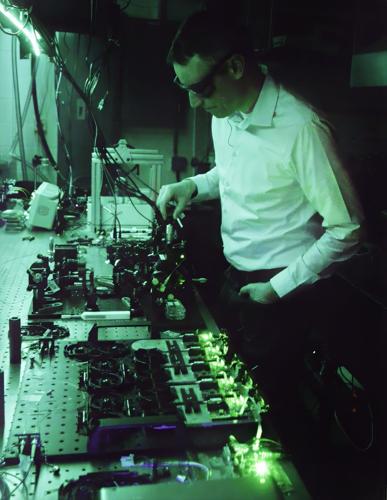Feds invest in Nobel Prize winning technology developed at CU Boulder

Long Path Technologies co-founder and Chief Technology Officer Dr. Greg Rieker adjusts a micrometer on a test-bed frequency comb laser system developed at the University of Colorado Boulder to detect and quantify methane leaks at oil and gas facilities Feb. 21, 2024. The green light is an artifact of the special fiber-optics that act as amplifiers for the infrared light.
Scott Weiser/Denver Gazette
A Boulder company just landed federal funding to further develop Nobel Prize winning technology that continuously detects and quantifies methane emitted by oil and gas facilities using a laser that interacts only with methane gas molecules.
The U.S. Department of Energy issued a $189 million conditional loan commitment on Jan. 5 to LongPath Technologies, Inc. of Boulder to fund the manufacture and deployment of its Active Emissions Overwatch System in “key U.S. oil and gas production basins.” The technology was developed at the University of Colorado Boulder.
“LongPath is a greenhouse gas detection technology company,” said President and CEO Ian Dickinson in an interview. “We provide greenhouse gas detection, primarily methane detection for a variety of industries. Our focus is really around oil and gas, but we also have applications in landfills, mining, agriculture, and wastewater.”
In 2013, the federal Advanced Research Projects Agency for Energy called for proposals on monitoring methane emissions from oil and gas facilities less expensively than was currently available.
After receiving funding from ARPA-E, LongPath co-founder Dr. Greg Rieker — a professor at the CU School of Mechanical Engineering — and his team began working on adapting what’s called the frequency comb laser into a commercial product that could be deployed in oil and gas regions to provide continuous monitoring for methane emissions.
LongPath was formed in 2017 to write grants to fund the company — which it received in 2018. The company then developed and fielded its commercial methane detection system while Rieker and his team continued work on frequency comb lasers at CU to adapt the technology for other uses.
Some potential uses include: detection of other air pollutants; measuring flow rates of individual gasses in a mixture of gasses flowing through a pipe; measuring products of combustion in a hydrogen tractor engine; and measuring high-speed chemical reactions in hypersonic engines.
LongPath’s first phase of deployment will set up 1,000 transmitter/receiver nodes that can cover up to 20,000 oil & gas sites. Each node can effectively monitor up to 20 sites within in a six-mile diameter circle, and the entire phase one system will encompass more than 18 million acres.
“The loan will support the scaling of LongPath methane detection and quantification technology to include 1,000 large-area remote methane monitors across Texas, Oklahoma, Kansas, Colorado, North Dakota, and New Mexico, serving as a game-changer for emissions detection, localization, and quantification,” said Rachael Shayne, spokesperson for LongPath.
Brian Halchak, manager of environmental services at the Williams Companies, a natural gas infrastructure developer based in Tulsa, Oklahoma, told The Denver Gazette his company is investing in LongPath to better monitor their own emissions.
“One advantage of having more frequent monitoring is better data,” Halchak said. “And as we utilize and leverage more actual monitoring technologies, we can get a better understanding of the frequency of the emissions that we have and the magnitude of those emissions, which helps give us more information on how we most effectively reduce emissions at our facilities.”
LongPath’s technology was adapted from technology used at the National Institutes of Standards and Technology in Boulder to precisely measure time and distance.
Based on theoretical quantum physics about photons postulated by Albert Einstein in 1917, the breakthrough in frequency comb lasers came in 1999. That’s when Nobel Prize winner and NIST Senior Fellow Emeritus John L. “Jan” Hall figured out how to create extremely short pulses of laser light that comprised a spectrum of light dubbed the laser frequency comb.
Somewhat like listening to cacophony of hundreds of slightly off-tuned instruments in an orchestra and then picking out the one particular instrument that’s in tune by ear, a frequency comb laser outputs millions of discrete frequencies of light, each of which is absorbed by a different kind of gas molecule in the atmosphere. By measuring the difference in the amount of the tuned light output and the amount received back from a retro-reflecting mirror, the concentration of a specific gas can be calculated.
“Because every molecule is different — like methane has carbon and four hydrogens, water has an oxygen with two hydrogens — each molecule is different,” LongPath co-founder Dr. Greg Rieker, a professor at the CU School of Mechanical Engineering, told The Denver Gazette. “So, it has different colors of light that it will absorb. That’s the beauty of the frequency comb. You’ve got all these colors of light that are being absorbed in different patterns. You send all that light out, you get it back, and you can tell what’s in the air.”
Because the light absorption frequency is different for each gas, a molecule of nitrogen, which makes up 79% of the atmosphere, will not absorb photons tuned to the absorption frequency of methane — thus not interfering with the measurement of methane.
The next step, Rieker said, is to take all of the laser light now being put through a large array of lenses and mirrors on his experimental table and condense it down to fit on what’s called a photonic integrated circuit, where the light is injected into specialized wafers that create the same processes in miniature.
“So, come back in two years and I think we’ll have a small box, but we’re not quite there yet,” said Rieker.
As an aside, Rieker pointed out that the physics he uses every day prove the greenhouse gas warming theory.
“I get this question all the time as a scientist, ‘Do you believe in climate change?’ The answer is it’s definitely real. We measure it every day and we leverage it to actually find the greenhouse gases,” he said.
“The greenhouse gas problem is that sunlight comes in mostly at visible and ultraviolet wavelengths,” said Rieker. “It goes right through the atmosphere, doesn’t interact with the molecules, hits the ground, warms it up, and then the earth is radiating infrared light back out and it gets absorbed by the molecules just the same way our laser beam gets absorbed.”
Rieker’s focus is on creating technology that will allow leak detection so it can be fixed.
“I mean the cool thing about methane is it’s a solvable problem. CO2 is hard,” Rieker added. “We have to burn fuel to run our cars, to run our engines, to heat our houses. So, we’re going to end up with CO2 one way or another. But with methane it’s also the product. So why not keep the methane in the pipes, deliver it to market and keep it out of the atmosphere.”



